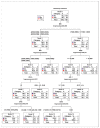A Decision-Tree Approach to Assist in Forecasting the Outcomes of the Neonatal Brain Injury
- PMID: 33946326
- PMCID: PMC8124811
- DOI: 10.3390/ijerph18094807
A Decision-Tree Approach to Assist in Forecasting the Outcomes of the Neonatal Brain Injury
Abstract
Neonatal brain injury or neonatal encephalopathy (NE) is a significant morbidity and mortality factor in preterm and full-term newborns. NE has an incidence in the range of 2.5 to 3.5 per 1000 live births carrying a considerable burden for neurological outcomes such as epilepsy, cerebral palsy, cognitive impairments, and hydrocephaly. Many scoring systems based on different risk factor combinations in regression models have been proposed to predict abnormal outcomes. Birthweight, gestational age, Apgar scores, pH, ultrasound and MRI biomarkers, seizures onset, EEG pattern, and seizure duration were the most referred predictors in the literature. Our study proposes a decision-tree approach based on clinical risk factors for abnormal outcomes in newborns with the neurological syndrome to assist in neonatal encephalopathy prognosis as a complementary tool to the acknowledged scoring systems. We retrospectively studied 188 newborns with associated encephalopathy and seizures in the perinatal period. Etiology and abnormal outcomes were assessed through correlations with the risk factors. We computed mean, median, odds ratios values for birth weight, gestational age, 1-min Apgar Score, 5-min Apgar score, seizures onset, and seizures duration monitoring, applying standard statistical methods first. Subsequently, CART (classification and regression trees) and cluster analysis were employed, further adjusting the medians. Out of 188 cases, 84 were associated to abnormal outcomes. The hierarchy on etiology frequencies was dominated by cerebrovascular impairments, metabolic anomalies, and infections. Both preterms and full-terms at risk were bundled in specific categories defined as high-risk 75-100%, intermediate risk 52.9%, and low risk 0-25% after CART algorithm implementation. Cluster analysis illustrated the median values, profiling at a glance the preterm model in high-risk groups and a full-term model in the inter-mediate-risk category. Our study illustrates that, in addition to standard statistics methodologies, decision-tree approaches could provide a first-step tool for the prognosis of the abnormal outcome in newborns with encephalopathy.
Keywords: abnormal outcomes; decision-tree algorithms; neonatal brain injury; neurodevelopment; risk factors; seizures.
Conflict of interest statement
The authors declare no conflict of interest.
Figures


References
-
- Iliodromiti Z., Zygouris D., Karagianni P., Belitsos P., Daniilidis A., Vrachnis N. Neonatal Care, Deborah Raines and Zoe Iliodromiti. IntechOpen; London, England: 2012. Chapter4-brain injury in preterm infants; pp. 73–86. - DOI
Publication types
MeSH terms
LinkOut - more resources
Full Text Sources
Medical

